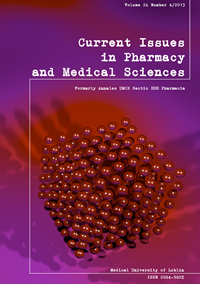Surgical treatment of dentoalveolar injury in the anterior region of maxilla
DOI:
https://doi.org/10.12923/j.2084-980X/26.4/a.11Keywords:
alveolar fracture, tooth extrusion, splinting, apical fractureAbstract
Traumatic injuries of teeth and alveolar bone are common in oral surgery departments. Maxillary incisors are the most frequently injured teeth. The right diagnosis is crucial for proper treatment method. Time elapsed between the accident occurrence and emergency treatment plays an important role. The aim of our research work was to present a case of a 25-year old female patient referred to Chair and Department of Oral Surgery, Medical University of Lublin who sustained dentoalveolar trauma of the maxillary anterior region including alveolar process fracture, extrusive luxation of all maxillary incisors, apical root fracture and lacerated upper lip. The surgical treatment consisted of repositioning the displaced teeth and alveolar bone fracture. The fracture was stabilized with the use of orthodontic brackets and orthodontic wire. PRP was used to promote bone healing after apicoectomy during second stage of surgical management.
References
1. Adams C., Jamszkiewes J., Judson J.: Changing patterns of severe craniomaxillofacial trauma in Auckland over eight years. AusNZSurg., 70, 401, 2000.
2. Andreasen J.O (1981).: Traumatic injuries of the teeth. 2nd edn. Copenhagen: Munksgaard; p.19-24.
3. Andreasen J.O. et al.: Effect of treatment delay upon pulp and periodontal healing of traumatic dental injuries – a review article. Dent. Traumatol., 18, 116, 2002.
4. Andreasen J.O. et al.: Healing of 400 intra-alveolar root fractures. 2. Effect of treatment factors such as treatment delay, repositioning, splinting type and period and antibiotics. Dent. Traumatol.; 20, 203, 2004.
5. Arathi R., Ashwini R., Ramya S.: Splinting – When and How. J Dent Update, 38, 341, 2011.
6. Bastone E.B., Freer T.J., McNamara J.R.: Epidemiology of dental trauma: A review of the literature. Aust. Dent. J., 45, 2, 2000.
7. Caliskan M.K., Turkun M.: Clinical investigation of traumatic injuries of permanent incisors in Izmir, Turkey. Endod. Dent. Traumatol., 11, 210, 1995.
8. Carlin C. et al.: Facial fractures and related injuries: A ten-year retrospective analysis. J. Cranimaxillofacial Trauma, 4, 44, 1998.
9. De Rossi M. et al.: Management of a complex dentoalveolar trauma: a case report. Braz. Dent. J., 20, 259, 2009.
10. Ellis R.G. (1970): The classification and treatment of injuries to the teeth of children. 5th edn. Chicago: Year Book Medical Publishers, p. 56-199.
11. Koyuturk A.E., Kusgoz A.: Multiple dentoalveolar traumatic injury: a case report (3 years follow up). Dent. Traumatol., 24, 16, 2008.
12. Rai B. et al.: Combination of platelet-rich plasma with polycaprolactone-tricalcium phosphate scaffolds for segmental bone defect repair. J. Biomed. Mater. Res. A., 81, 888, 2007.
13. von Arx T., Filippi A., Lussi A.: Comparison of a new dental trauma splint device (TTS) with three commonly used splinting techniques. Dent. Traumatol., 17, 266, 2001.
14. World Health Organization. (1995): Application of the International Classification of Diseases to Dentistry and Stomatology (ICD-DA). Third edition. Geneva: World Health Organization, p. 114.
15. Yonezawa H. et al.: Management of maxillary alveolar bone fracture and severely intruded maxillary central incisor: report of a case. Dent. Traumatol., 29, 416, 2013.
Downloads
Published
Issue
Section
License
Copyright (c) 2013 Authors

This work is licensed under a Creative Commons Attribution-NonCommercial-NoDerivatives 3.0 Unported License.


